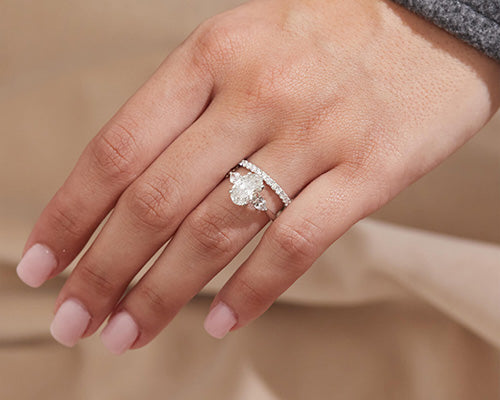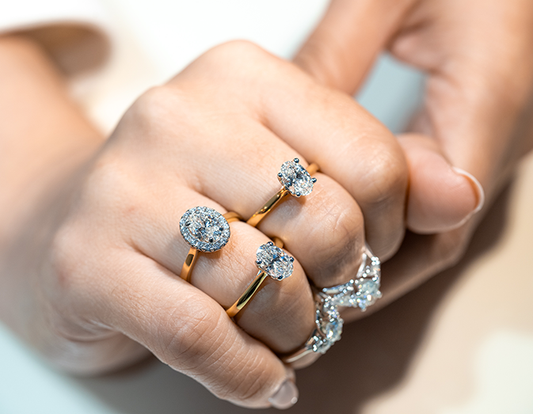Diamond Buying Guide
Buying a diamond is a meaningful moment—whether it’s to celebrate a milestone, a special occasion, or simply to treat yourself. Understanding the key elements of a diamond will help you find the perfect piece that suits your style and budget. This guide will take you through the essentials, from the Four C’s to diamond shapes and settings, and why lab-grown diamonds are an exceptional choice.
Top things to consider when buying a diamond:
The Four C’s: Cut, Colour, Clarity, and Carat Weight
Different diamond shapes—each with its own unique character
Diamond settings and how they enhance the stone’s beauty
The Four C's When Buying a Diamond
Carat
Carat refers to the weight of a diamond rather than its physical size. A higher carat weight generally means a larger diamond, but proportions and cut quality also play a role in how big a diamond appears.
What is a carat?
One carat equals 0.2 grams and is divided into 100 points. A 0.50-carat diamond is often called a half-carat diamond, while a 1.00-carat diamond is a full carat.
Does size matter?
Carat weight isn’t the only factor to consider when choosing a diamond. Some cuts create an illusion of a larger stone, while certain settings can enhance its presence. Elongated shapes like oval or emerald cuts tend to appear larger than a round diamond of the same carat weight.
Total Carat Weight (TCW):
When purchasing jewellery with multiple diamonds, the total carat weight includes all stones combined. For example, a pair of 0.25-carat diamond earrings means each earring holds a 0.125-carat diamond.
Colour
Diamonds are graded from D (colourless) to Z (light yellow or brown). Colourless diamonds are rare and highly valued, while those with slight warmth offer a beautiful glow and a more accessible price point.
D-F (Colourless): Pure and icy, with no detectable colour.
G-J (Near Colourless): A slight warmth may be visible in larger stones, but these diamonds still appear bright and white.
K-M (Faint Colour): Noticeable warmth but still a brilliant choice depending on personal preference.
Lab-grown diamonds, like those from Born, are available in a wide range of colours and offer exceptional beauty without compromise.
Cut
The cut of a diamond impacts how well it reflects light, influencing its brilliance and sparkle. A well-cut diamond will have ideal proportions and symmetry to maximise its fire and brilliance.
Key Cut Features:
Proportions: Determines how well light moves through the stone.
Symmetry: Well-aligned facets create a harmonious, balanced look.
Polish: A smooth finish ensures optimal light reflection.
Round brilliant diamonds have the most sparkle due to their precise facet arrangement, but fancy shapes like oval, emerald, and pear cuts also offer distinct beauty.
Clarity
Clarity refers to the presence of natural inclusions, or tiny internal features, within a diamond. These are unique characteristics that form during the diamond’s growth process.
How is clarity graded?
FL, IF (Flawless/Internally Flawless): Extremely rare, with no visible inclusions even under magnification.
VVS1, VVS2 (Very, Very Slightly Included): Nearly flawless, with only minute inclusions visible under magnification.
VS1, VS2 (Very Slightly Included): Minor inclusions that are difficult to detect with the naked eye.
SI1, SI2 (Slightly Included): Some inclusions may be visible without magnification but do not impact durability.
I1-I3 (Included): Visible inclusions that may affect the diamond’s brilliance.
Born diamonds are carefully selected to offer exceptional clarity, ensuring each stone has a beautiful, luminous appearance.
Diamond Shapes
Shape defines the overall silhouette of a diamond, and each shape carries its own unique charm.
Round Brilliant: The most popular cut, maximising sparkle and fire.
Princess Cut: A modern, square shape with sharp corners and brilliant faceting.
Emerald Cut: Rectangular with step-cut facets for a sophisticated, mirrored effect.
Oval Cut: An elongated shape that enhances finger length and maximises perceived size.
Pear Cut: A teardrop shape combining elegance with unique brilliance.
Whether you prefer classic or contemporary, the shape of your diamond is a personal choice that reflects your style.
Diamond Settings
A setting enhances a diamond’s beauty while securing it in place. Here are some popular options:
Claw (Prong) Setting: A classic choice that allows maximum light to pass through the diamond.
Rubover (Bezel) Setting: A sleek, modern setting that encases the diamond for extra security.
Pavé Setting: Small diamonds set close together for an all-over sparkle effect.
Tension Setting: The diamond appears to float, creating a striking, contemporary look.
The right setting can enhance the overall appearance of your diamond, so consider your style and how you’ll wear your piece daily.
Lab-Grown vs. Earth-Grown Diamonds
Both lab-grown and earth-grown diamonds are optically, chemically, and physically identical. The only difference is their origin—lab-grown diamonds are created in controlled environments using advanced technology that replicates natural diamond formation.
Why choose a lab-grown diamond?
l Ethically sourced with no mining required.
l Exceptional quality, graded using the same standards as mined diamonds.
l More accessible pricing, offering better value for your budget.
l A sustainable choice with a lower environmental impact.
Born diamonds embody innovation and craftsmanship, providing a modern, responsible way to own a stunning diamond. If you’d like to explore more about lab-grown diamonds, read our full guide.
Choosing the right diamond is a personal journey, and with Born, you can find a piece that aligns with your style and values. Whether you’re celebrating a special occasion or treating yourself, our collection of lab-grown diamonds ensures brilliance and beauty without compromise.

